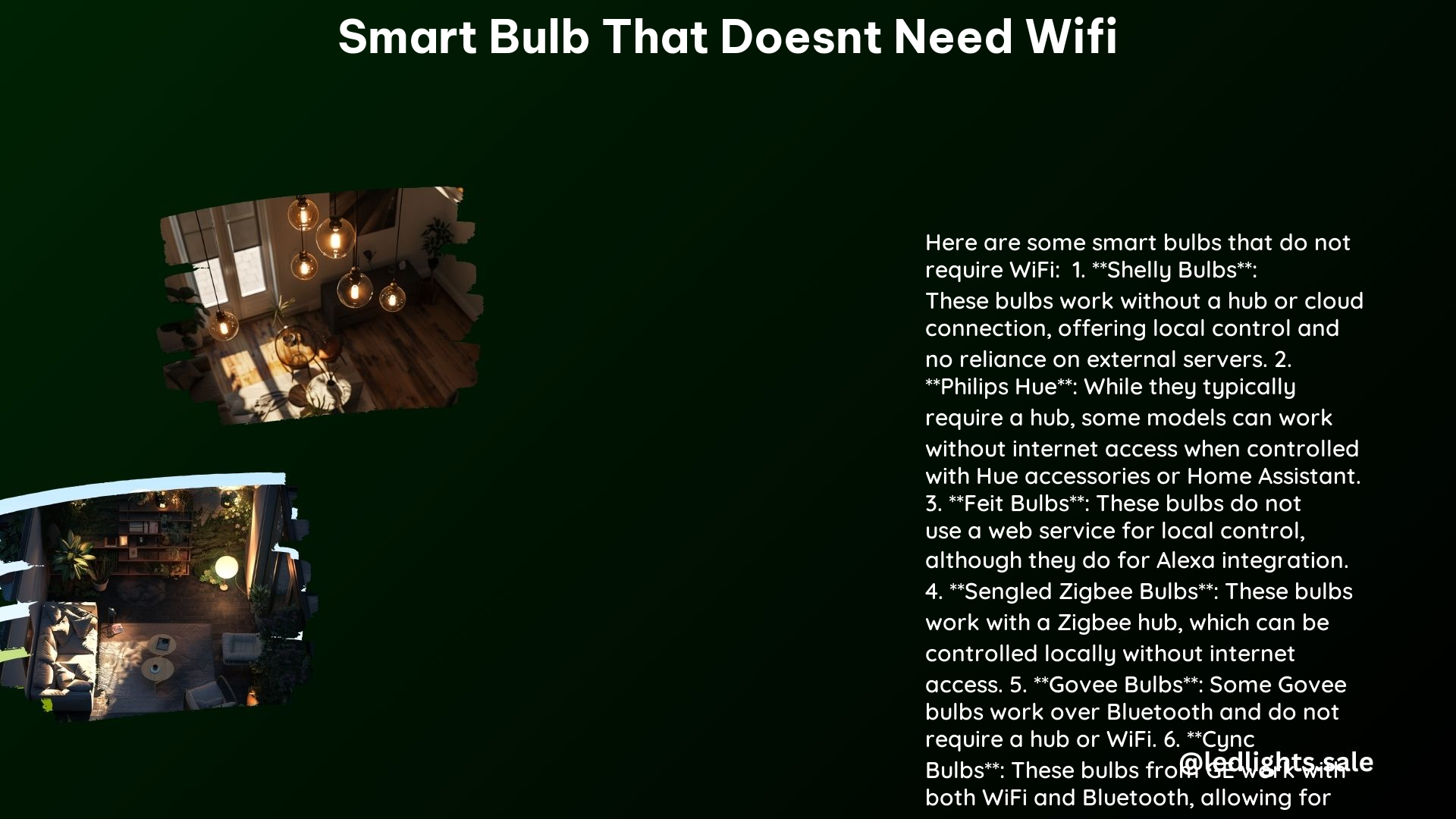Smart home technology has revolutionized the way we interact with our living spaces, and smart bulbs have become an integral part of this revolution. However, not everyone has access to a reliable WiFi connection, or they may prefer to keep their smart home devices separate from their internet-connected network. Fortunately, there are several options available for smart bulbs that don’t require a WiFi connection, offering a range of features and connectivity options.
Bluetooth Bulbs: Wireless Convenience Without the Internet
Bluetooth-enabled smart bulbs are a popular choice for those who want to control their lighting without relying on a WiFi network. These bulbs use Bluetooth connectivity to communicate directly with your smartphone or other Bluetooth-enabled devices, allowing you to adjust the brightness, color, and other settings without the need for a hub or router.
One of the leading examples of Bluetooth smart bulbs is the Philips Hue Bluetooth Bulb. These bulbs can be controlled directly from your smartphone or tablet, without the need for the Philips Hue Bridge. However, it’s important to note that while you can control the bulbs locally without WiFi, you’ll need the Hue Bridge if you want to access them remotely or integrate them with other smart home devices.
Technical Specifications of Philips Hue Bluetooth Bulb
- Connectivity: Bluetooth
- Hub Required: No (for local control), Yes (for remote access)
- Compatibility: Works with Alexa and Google Assistant
- Bulb Type: A19 (standard size)
- Lumens: 806 (equivalent to a 60W incandescent bulb)
- Color Temperature: 2200K to 6500K (adjustable)
- Lifetime: Up to 25,000 hours
- Voltage: 120V
- Wattage: 9.5W
Zigbee Bulbs: Mesh Networking for Reliable Local Control

Zigbee is another wireless protocol that enables smart bulbs to communicate without the need for a WiFi connection. Zigbee bulbs use a mesh network, where each device acts as a node, relaying signals to other devices in the network. This allows for reliable and robust communication, even in areas with poor WiFi coverage.
One example of a Zigbee smart bulb is the Sengled Zigbee Bulb. These bulbs require a Zigbee hub, such as the Sengled Hub, to function, but they can be controlled locally without an internet connection. This makes them a great choice for areas with limited or unreliable WiFi, or for users who want to keep their smart home devices separate from their internet-connected network.
Technical Specifications of Sengled Zigbee Bulb
- Connectivity: Zigbee
- Hub Required: Yes
- Compatibility: Works with Alexa and Google Assistant
- Bulb Type: A19 (standard size)
- Lumens: 800 (equivalent to a 60W incandescent bulb)
- Color Temperature: 2700K to 6500K (adjustable)
- Lifetime: Up to 25,000 hours
- Voltage: 120V
- Wattage: 9W
Thread Bulbs: The Future of Mesh Networking for Smart Homes
Thread is a newer wireless protocol that is gaining traction in the smart home market. Like Zigbee, Thread uses a mesh network to enable direct communication between devices, without the need for a central hub or WiFi connection.
One example of a Thread-enabled smart bulb is the Nanoleaf Essentials Bulb. These bulbs can be controlled locally without an internet connection, and they can also be integrated with other Thread-compatible devices to create a seamless smart home ecosystem.
Technical Specifications of Nanoleaf Essentials Bulb
- Connectivity: Thread
- Hub Required: No
- Compatibility: Works with Alexa and Google Assistant
- Bulb Type: A19 (standard size)
- Lumens: 806 (equivalent to a 60W incandescent bulb)
- Color Temperature: 2700K to 6500K (adjustable)
- Lifetime: Up to 25,000 hours
- Voltage: 120V
- Wattage: 9W
Use Cases for Smart Bulbs Without WiFi
Smart bulbs that don’t require a WiFi connection can be particularly useful in a variety of scenarios:
-
Basement or Room Without WiFi: In areas of your home where WiFi coverage is poor or non-existent, such as a basement or a remote room, you can use Bluetooth, Zigbee, or Thread-enabled smart bulbs to provide lighting control without relying on the internet.
-
Photography: When setting up a photoshoot or video production, you may need to add colored lighting to a scene. Smart bulbs that don’t require WiFi can be a great solution, as you can control the lighting without needing to connect to the internet.
-
Remote Areas: In remote locations with limited or unreliable internet access, such as a cabin or a campsite, smart bulbs that use alternative connectivity methods can be a practical solution for lighting control.
-
Reducing WiFi Burden: By using smart bulbs that don’t rely on WiFi, you can reduce the overall burden on your home network, freeing up bandwidth for other internet-connected devices.
Conclusion
Smart home technology has come a long way, and the availability of smart bulbs that don’t require a WiFi connection is a testament to the innovation in this field. Whether you’re looking for Bluetooth, Zigbee, or Thread-enabled bulbs, there are plenty of options to choose from, each with its own set of features and technical specifications.
By understanding the capabilities and use cases of these WiFi-independent smart bulbs, you can make an informed decision and create a smart home that meets your specific needs, even in areas with limited or unreliable internet access.
